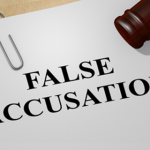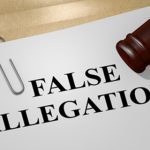The Law on Making False Complaints to Police in New South Wales

It is criminal offence in New South Wales to make false accusations with the intention of having them investigated by police.
The offences against false reports are contained in the Crimes Act 1900 (NSW).
Section 547B of the Act is headed ‘public mischief’ and prescribes a maximum penalty of two years’ imprisonment for knowingly making a false representation to a police officer that an act has occurred, or will occur, so as to call for a police investigation.
The offence can be established regardless of whether the statement was made directly to police or to another party where it would reasonably require reporting to police.
In addition, section 314 of the Act is titled ‘false accusations’ and sets down a maximum penalty of seven years in prison for making an accusation against another person with the intention of subjecting that person to an investigation while knowing the person is innocent.
However, the laws against false complaints don’t always prevent people from making them.
In fact, such complaints are made any of a number of reasons, from revenge against former partners, to bolstering family law proceedings, and even to gain sympathy and publicity.
Aggrieved actor seeks publicity
In the United States, where false complaints are also a serious offence, actor Jussie Smollett is alleged to have made a false report to police of being the victim of a hate crime.
Allegedly upset about his salary and waning popularity, the actor reported being attacked by two Donald Trump supporters in Chicago for being black and gay.
His story evoked imagery of the country’s racist past, with Smollett claiming to have had a noose placed around his neck and assaulted. The report led US politicians to say it amounted to a “modern-day lynching”.
The problem was that an investigation by Chicago police found that the event never occurred, leading to Smollett’s arrest and charge for making a false accusation – a felony which carries a maximum penalty of three years behind bars.
Hate crime hoaxes
The term “racial hoax” was popularised by American author Katheryn Russel-Brown to describe the fabrication of a racially motivated crime, or the misidentification of race as the motivation for an actual crime.
The term was traditionally used to blame blacks for crimes that never occurred, as blaming this group made the events seem more believable and evoked greater sympathy for the alleged victim and triggered more public outrage.
In 1992, for example, Jessie Anderson stabbed his wife and then superficially stabbed himself, before claiming two African-American men had committed the crime. Mr Anderson’s plan to evade justice fell apart when a basketball cap he claimed to have knocked off the offender’s head turned out to be his own.
Ms Russel-Brown documented 67 racial hoax cases between 1987 and 1996, 70% of which were white-on-black hoaxes. The false reports predominantly related to false sexual assault claims against black men, with more than half of them being debunked within a week.
But some of the claims have been by minorities claiming to have been victimised by nationalists. In December 2016, for example, student Yasmin Seweid claimed to have been attacked on a New York City subway by three white men who tore the hijab from her head while yelling “Donald Trump” and making anti-Islamic slurs.
Ms Seweid later admitted lying to distract her angry father from the fact she had actually been out all-night drinking with friends.
Frequency of hate crime hoaxes
The US Center for the Study of Hate and Extremism at California State University found that of an estimated 21,000 hate crimes between 2016 and 2018, fewer than 50 reports were found to be false. The center believes that less than 1% of all reported hate crimes are in fact false.
Motivation for false reports
Former FBI agent Cynthia Deitle says that in her 20 years investigating hate crimes, the most common motivation for false reports was the desire for attention and sympathy.
“They felt that being labeled a ‘hate crime victim’ would be a positive result,” Ms. Deitle remarked.
“Sometimes the allegation was made to draw attention away from a real negative aspect of the complainant’s life, like poor performance at work or school, or a feeling that the complainant was not getting the attention she or he deserved.”
In the context of growing identity politics, pretending to be the victim of a hate crime may provide an individual with certain social capital, particularly in activist circles, through legitimising their grievances about broader social issues.
The impact on legitimate victims
“Devastating is how I would describe this Smollett story, especially during this legislative season when some states are trying to pass hate crime reform bills,” said Brian Levin, a US hate crime expert and the California center’s director.
“This has the potential to eclipse the real facts about hate crimes.”
Despite the infrequency of hate crime hoaxes, many fear they have the potential to undermine legitimate complaints by making authorities less likely to believe them, and may even prevent genuine victims from coming forward.







